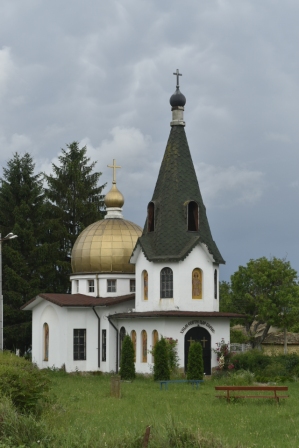We’ve still seen the occasional horse and cart as we’ve travelled down through Bulgaria but they are much smaller and seem to be used for personal transportation rather than the industry that was evident in Romania.
Again we are noticing that villages and areas have their own characteristics.
In one small village, old prams, with plastic boxes to load up, were the order of the day. It didn’t seem to matter if all 4 wheels we firmly attached & rotated. Four or five of these turned up and were parked outside the store while the owners toddled in to do their shopping.
A couple of villages, in close proximity to each other, were drying sliced mushrooms on racks along the road side.
On occasions mud bricks are being used. At first we saw a pile of them next to the road. Nearby there were some new homes where they had been used to make the walls; perhaps the rendering has not yet been applied. They have been quite frequently used to fill old door ways or window frames that are clearly no longer needed. Equally, where rendering has fallen off extensions or out-buildings it has exposed mud bricks.
Whilst contemplating where we might stop for the night we where on the look out for a campsite, or a cafe in which we could stop, get refreshments and peruse the map. The sun shades make the cafes quite easy to locate unlike grocery stores that frequently have no advertising or signage at all. On entering Straldza however, both of us quaked as it was evident that the cafe was on the edge of a shanty town. Fearing the attention we would attract, we sped past but found a very nice cafe, shop and cheap hotel at the other end of the village. Thankfully, we were once again under a solid roof when the storm came through.
Heat and hills is becoming the norm but thankfully there are quite frequent water springs along the way providing refreshing cool water. Both the Bulgarians and Turks fit the roadside springs out with pipes and a trough, perhaps a habit left over from horse drawn days. Very welcome and nice water too. We’ve both taken to sticking our heads under the water flow before filling our bottles.
The views from the hill tops are beautiful and on occasions it even feels worth the climb.
Our Bulgarian map was a 400k Reiss Know-How map, and proved one of the most informative at this scale, with some contours, and waterproof too. The key didn’t explain what the symbols for places meant, so here’s ours:
- Urban area 1cm or more on map: Will have most facilities. Choice of hotels but obvious ones may be pricey. Probably a nice centre bit. Big enough to get lost in.
- Urban area 5mm to 9mm. There will be at least one hotel/motel/guesthouse. You may have to ask around in shop or street corner to find it. It may be on the edge of town. It will probably be 40-60 Bulgarian (20-30 euro) for room for two, excluding any food. There will be an in-hotel or nearby restaurant. There will be more than one food shop, and they will have fresh fruit and reasonable bread.
- Big dot. No place to stay. Some kind of bar or cafe (may not do hot drinks). One shop, at extreme edge of viability: No fresh products, bread may be mouldy or end dated; vaguely disquieting smell. Difficult to get even UHT milk, or cheese. Although a fresh cheese is sometimes available from a concealed bucket. This is an interesting contrast with Romania, where little village shops were normally selling fresh bread, and tomatoes, cucumbers at least, and generally seemed viable.
- Small dot: Just houses, a good proportion falling down.
Later, in Turkey, we encountered three French lads cycling in the opposite direction, and we swapped the excellent Bulgaria map for their equally useful, same publisher, Central Asia map – a perfect trade for both of us.
The other interesting contrast between Romanian and Bulgarian villages is that the former are always a wide main street with houses spaced along both sides. Bulgarian villages are more houses around an area, with side streets, and usually a consciously designed, open, central square, with some communist-era fair sized buildings around (often semi deserted). And in maybe a fifth, it seems like all the houses were demolished and replaced with small apartment blocks, 1 to 5 in a village. They’re often in poor repair.



















